Toyota Corolla (E210) 2019-2025 Owners Manual / When trouble arises / Steps to take in an emergency / If your vehicle needs to be towed
Toyota Corolla (E210): If your vehicle needs to be towed
If towing is necessary, we recommend having your vehicle towed by your Toyota dealer or commercial towing service, using a wheel-lift type truck or flatbed truck.
Use a safety chain system for all towing, and abide by all state/provincial and local laws.
WARNING
Observe the following precautions.
Failure to do so may result in death or serious injury.
■When towing the vehicle
Be sure to transport the vehicle with the front wheels raised or with all four wheels raised off the ground. If the vehicle is towed with the front wheels contacting the ground, the drivetrain and related parts may be damaged.
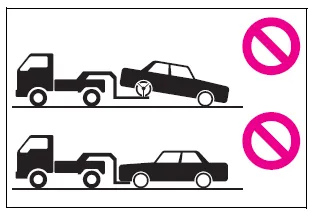
■While towing
- When towing using cables or chains, avoid sudden starts, etc. which place excessive stress on the towing eyelets, cables or chains. The towing eyelets, cables or chains may become damaged, broken debris may hit people, and cause serious damage.
- Do not turn the engine switch
off.
There is a possibility that the steering wheel is locked and cannot be operated.
■Installing towing eyelets to the vehicle
Make sure that towing eyelets are installed securely.
If not securely installed, towing eyelets may come loose during towing.
NOTICE
■To prevent damage to the vehicle when towing using a wheel-lift type truck
- Vehicles without a smart key system: Do not tow the vehicle from the rear when the engine switch is off or the key is removed. The steering lock mechanism is not strong enough to hold the front wheels straight.
- Vehicles with a smart key system: Do not tow the vehicle from the rear when the engine switch is off.
- When raising the vehicle, ensure adequate ground clearance for towing at the opposite end of the raised vehicle. Without adequate clearance, the vehicle could be damaged while being towed.
NOTICE
■To prevent damage to the vehicle when towing with a sling-type truck
Do not tow with a sling-type truck, either from the front or rear.
■To prevent damage to the vehicle during emergency towing
Do not secure cables or chains to the suspension components.
Situations when it is necessary to contact dealers before towing
The following may indicate a problem with your transmission.
Contact your Toyota dealer or commercial towing service before towing.
- The engine is running but the vehicle does not move.
- The vehicle makes an abnormal sound.
Towing with a wheel-lift type truck
From the front
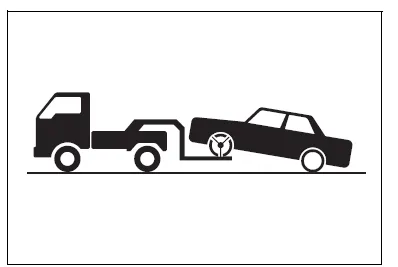
Release the parking brake.
Turn automatic mode off.
From the rear

Use a towing dolly under the front wheels.
NOTICE
■Towing with a sling-type truck
Do not tow with a sling-type truck to prevent body damage.
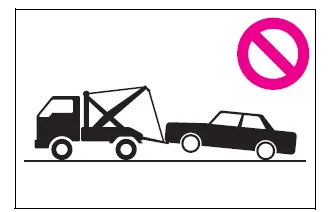
Using a flatbed truck
When using a flat-bed truck to transport the vehicle, use tire strapping belts. Refer to the owner's manual of the flat-bed truck for the tire strapping method.
In order to suppress vehicle movement during transportation, set the parking brake and turn the engine switch off.
Emergency towing (vehicles with a towing eyelet)
If a tow truck is not available in an emergency, your vehicle may be temporarily towed using cables or chains secured to the emergency towing eyelets. This should only be attempted on hard surfaced roads for at most 50 miles (80 km) at under 18 mph (30 km/h).
A driver must be in the vehicle to steer and operate the brakes.
The vehicle's wheels, drive train, axles, steering and brakes must be in good condition.
For vehicles with a continuously variable transmission, only the front towing eyelets may be used.
Emergency towing procedure (vehicles with a towing eyelet)
To have your vehicle towed by another vehicle, the towing eyelet must be installed to your vehicle. Install the towing eyelet using the following procedure.
1. Take out the wheel nut wrench and towing eyelet.
2. Remove the eyelet cover using a flathead screwdriver.
To protect the bodywork, place a rag between the screwdriver and the vehicle body as shown in the illustration.
Type A
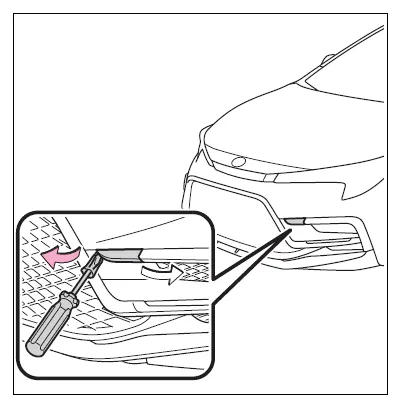
Type B
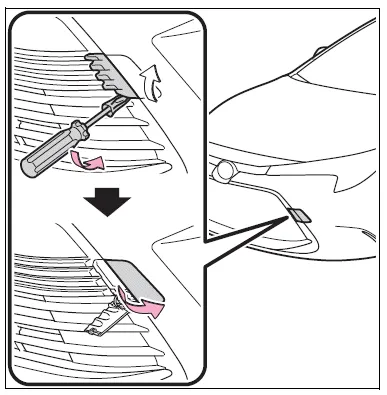
3. Insert the towing eyelet into the hole and tighten partially by hand.
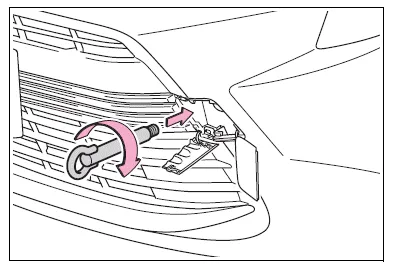
4. Tighten down the towing eyelet securely using a wheel nut wrench or hard metal bar.
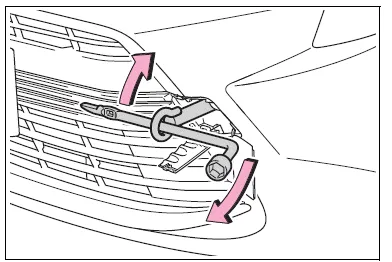
5. Securely attach cables or chains to the towing eyelet.
Take care not to damage the vehicle body.
6. Enter the vehicle being towed and start the engine.
If the engine does not start, turn the engine switch to ON.
7. Shift the shift lever to N and release the parking brake.
Turn automatic mode off.
When the shift lever cannot be shifted.
■While towing (vehicles with a towing eyelet)
If the engine is not running, the power assist for the brakes and steering will not function, making steering and braking more difficult.
■Wheel nut wrench (vehicles with a towing eyelet)
Wheel nut wrench is installed in trunk.
Other materials:
Symptom simulation
Hint:
the most difficult case in troubleshooting is when no symptoms occurs. In such
cases, a thorough customer
problem analysis must be carried out. Then the same or similar conditions and
environment in which the
problem occurred in the customer’s vehicle should be simulated. No matter ho ...
Circuit description
The fuel trim is related to the feedback compensation value, not to the basic
injection time. The fuel trim includes
the short–term fuel trim and the long–term fuel trim.
The short–term fuel trim is the short–term fuel compensation used to maintain
the air–fuel ratio at stoichiomet ...
Inspection procedure
Hand–held tester:
1 Check fuel tank cap assy(check that fuel tank cap is toyota
genuine parts)
2 Check that fuel tank cap is correctly installed
3 Inspect fuel tank cap assy
4 Check filler neck for damage
Remove the fuel tank cap.
visually check the fuel inlet pipe for ...


